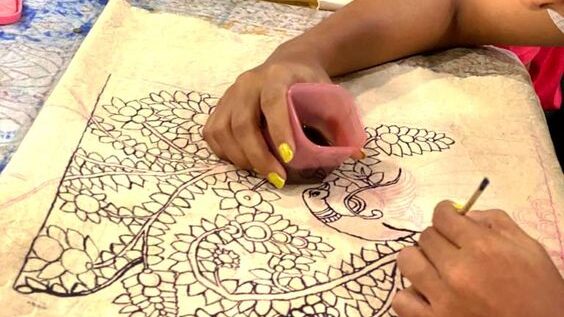What is Kalamkari Art?
Kalamkari Art, among traditional Indian arts, is one of the very few that arouses curiosity. It portrays India’s cultural richness and artistic abilities as seen through a long history and complexity. This art originated from ancient days when it was highly respected and even today, it has continued to impress both amateurs and experts with its colorful dyes and detailed patterns.
The title implies that the article will talk about rediscovering the timeless beauty of Kalamkari art in India. ‘‘Steeped in history’’ implies that this type of art goes back in time. Traditional Indian artistry is used here to refer to Kalamkari as well as other forms of Indian painting. by saying that “its origins can be traced back to ancient times…flowered into a revered form by then,” it means that it started during ancient times when it was highly regarded before developing into an adored form up to now.
Exploring the Origins with Kalamkari art
The word ‘Kalamkari’ is derived from the Persian words ‘kalam’ which in turn means pen and ‘kari’ which means crafting, signifying the pen work. In India, traditional tie and die is believed to have originated from the temples and royal courts, where artisans would devotedly paint patterns on textiles, predominantly cottons and silks, with natural dyes and bamboo or date palm stick.
Two Distinct Styles of Kalamkari art
There are two forms of Kalamkari art — The Srikalahasti and Machilipatnam styles, named after the towns where they originated. The Srikalahasti style is known for its free-hand drawing and fine details, usually depicting religious motifs, celestial beings and mythical stories. Meanwhile, the Machilipatnam style is famous for its bright colours and heavy outlines, which normally play host to flowers, geometric shapes, as well as elements derived from nature.
The Intricate Process
What sets Kalamkari aside isn’t just its aesthetic enchantment but additionally the hard work-intensive procedure worried in developing every masterpiece. The journey begins with making ready the canvas, typically cotton or silk material, thru a series of washing and bleaching to take away impurities and achieve a clean texture. Next comes the sketching level, in which professional artisans use a pointed bamboo stick dipped in a aggregate of water and bleaching marketers to outline the design.
Once the shape is drawn, comes the most important step – color. The use of natural pigments extracted from plants, roots and minerals infuses the artwork with life. Each color is carefully developed with a “kalam” or quill, and the skill of the artist determines the depth and intensity of the colors. It is repeated several times to achieve the desired richness and intensity of the colors.
Preserving Kalamkari art Tradition in the Modern World
In today’s fast paced world of mass production, traditional art forms like kalamkari are challenged to survive. However, in the midst of this modernization, the number of crafts and cultural heritage is increasing. Various organizations and artists are trying to preserve and promote Kalamkari through workshops, exhibitions and collaborations with contemporary artists.
Additionally, the advent of e-commerce platforms and social media has provided artists with a global platform to showcase their creativity and reach a wider audience This new form of exposure not only creates economic opportunities for artists but for them art lovers and artists find new interest around the world.
Beyond Aesthetics: Cultural Heritage
Beyond its rich aesthetics, Kalamkari has a deep sense as a custodian of India’s rich cultural heritage. Every painting, every example is imbued with symbolism, reflecting the spiritual, mythological and sociocultural beliefs of its creators. From scenes from Hindu epics like Ramayana and Mahabharata to celebrating nature’s gifts through exotic flowers, Kalamkari is a visual record of India’s history and character.
Furthermore, Kalamkari carries the spirit of sustainability and environmental consciousness long before it became a global phenomenon. The use of natural pigments and organic fabrics not only brightens the colors but also reduces the environmental footprint, making it a favorite for consumers the moral will.

Beautiful Kalamkari art writing that lasts forever
In a world where trends come and go, Kalamkari stands as a timeless testament to the enduring appeal of the traditional craft. Its intricate patterns and vibrant colors transcend the boundaries of time and space and continue to captivate hearts and minds. Whether decorating scenic runways or decorating the walls of humble abodes, Kalamkari weaves a tapestry of beauty, culture and heritage that is as vital today as it was centuries ago.
As we immerse ourselves in the mesmerizing world of Kalamkari, we not only celebrate the artistic genius of its creators but also pay homage to a cultural legacy that has withstood the test of time. In embracing Kalamkari, we embrace the essence of India – a land where tradition and modernity coexist in perfect harmony, where every stroke of the brush tells a story, and where beauty is not just seen but felt in the depths of our souls.

Get Free Art Caption Click here | Get Humorous Best Art Quotes Click here | Get one line short and Simple Hashtags Click here
Visit Our Website – www.ezeerun.com For All Kind of Artistic and Stationery Product. Follow on Instagram for more updates
.









